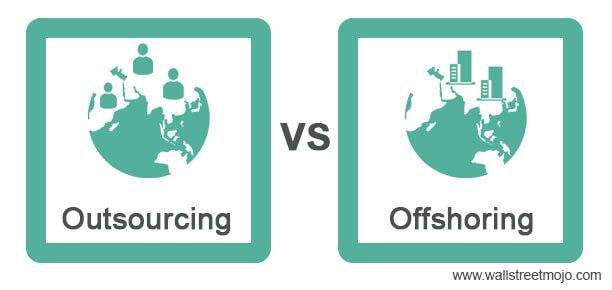Table Of Contents
Difference Between Outsourcing and Offshoring
In the case of outsourcing, the company's work is given on a contract basis to the external organization, and the company itself focuses on its core business activities. In contrast, in the case of offshoring, the company's business process is relocated to a different country with the motive of taking a lower-cost advantage in that country.

Offshoring and outsourcing are two tools of modern business. They have proved to be a game-changer in the modern-day era as the business margins have tightened, and companies have taken the route to save cost and bring efficiencies in the business.
What is Outsourcing?
When a company outsources a service or a product, it means that the company is not producing the service or a product themselves and has started purchasing that product or service from some vendor. For example, a United States company has outsourced certain car parts manufacturing to a Chinese company.
What is Offshoring?
When a company talks about offshoring, it shifts the production location of a certain product or service to a different site for cost savings. As a result, there is a much bigger set-up of that product or service, which results in some cost savings for the company.
For example, a BPO company wants to relocate to a much cheaper place because it will reduce its FTE cost. This shift will result in much-improved processes and bring inefficiencies in the business. Although the ownership of the product or the service still lies with the company itself.
Outsourcing vs Offshoring Infographics
Let's see the top differences between outsourcing vs. offshoring.

Key Differences Between Outsourcing and Offshoring
- Offshoring means getting the work done in a different location or country. In contrast, outsourcing means contracting or subcontracting the work previously done by the organization to an external party specializing in the company's work.
- The objective of outsourcing is to focus more on the mainline of the activity or the business that the company has expertise in and not to focus on ancillary products or services which do not derive the major revenue pipeline of the company. The objective of offshoring is to lower the cost of that service or the process that the company is providing. Offshoring results in cost-saving and lower labor, but it does not necessarily mean that it will improve or enhance the work efficiency in the company.
- The non-employees of the company perform the outsourced task. As the process has been completely outsourced, it no longer comes within the scope of the company's operation. On the other hand, offshoring is performed by the company's employees as only the work location has been changed. In addition, the employees have been working on the company's payroll only, making the process much more familiar and fast track.
- In outsourcing, the skill-set does not change hands with the company's employees. The service is now being purchased by some other self-sufficient agency capable of getting the work done within the expectation grid and timelines. KPO agencies have been growing massively in South Asia due to this outsourcing. In offshoring, on the other hand, the skill-set which they are performing changes hands and results in the upgradation of the skill-set of the company's employees. Also, it is much cheaper and more cost-effective for the company performing the transformation.
Comparative Table
| Offshoring | Outsourcing |
|---|---|
| Performed by the staff of the existing company | Performed by the non-employees of the company as the service has been sourced |
| Offshoring is always performed outside the boundaries of the present work location as the shift of one center to another country is a must. | Outsourcing may be performed within the present country’s boundaries or outside the country. It does not necessarily change location because it is primarily a change of skill-set |
| Mostly cost-saving and cheap labor, which is required to do a work that demands less skill-set | The objective of outsourcing is to focus on the company's main business activity and not to make many efforts on the ancillary ones |
| Offshoring results in no cash outflow in the initial years of transformation cost and other things | Outsourcing results in cash outflow as the company needs to pay for the services it is rendering from external parties |
Conclusion
The business should decide whether to use these kinds of practices alone or combined. Combining both outsourcing and offshoring activities would result in much more cost savings. Moreover, recent trends have shown that both activities are on the rise.
The word-wide sluggish economy has given rise to these measures taken by the company to save their cost and make the business more efficient and dynamic. Another trend – especially in information technology (IT services) outsourcing – is industry consolidation, with larger companies acquiring smaller vendors.
